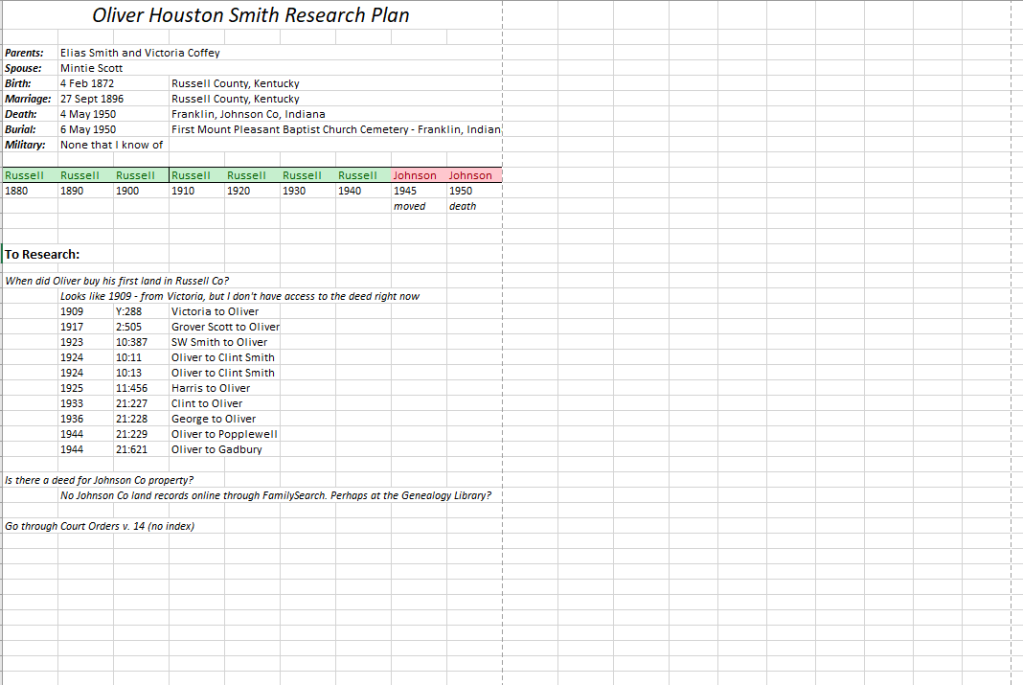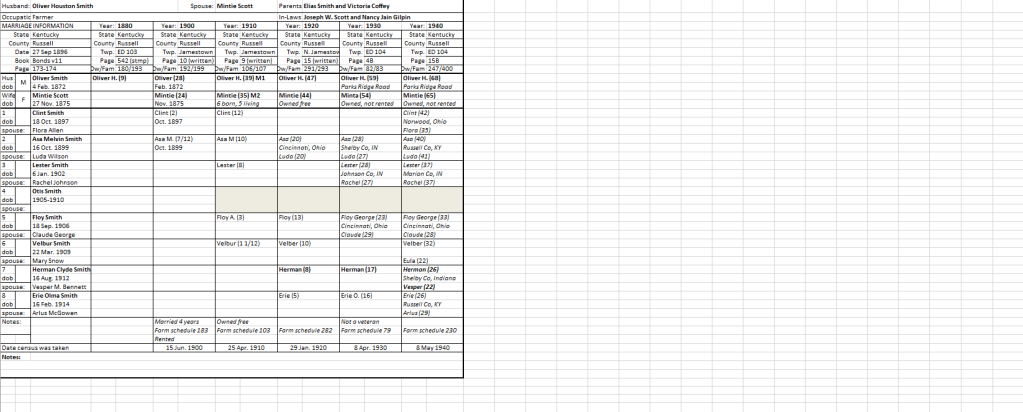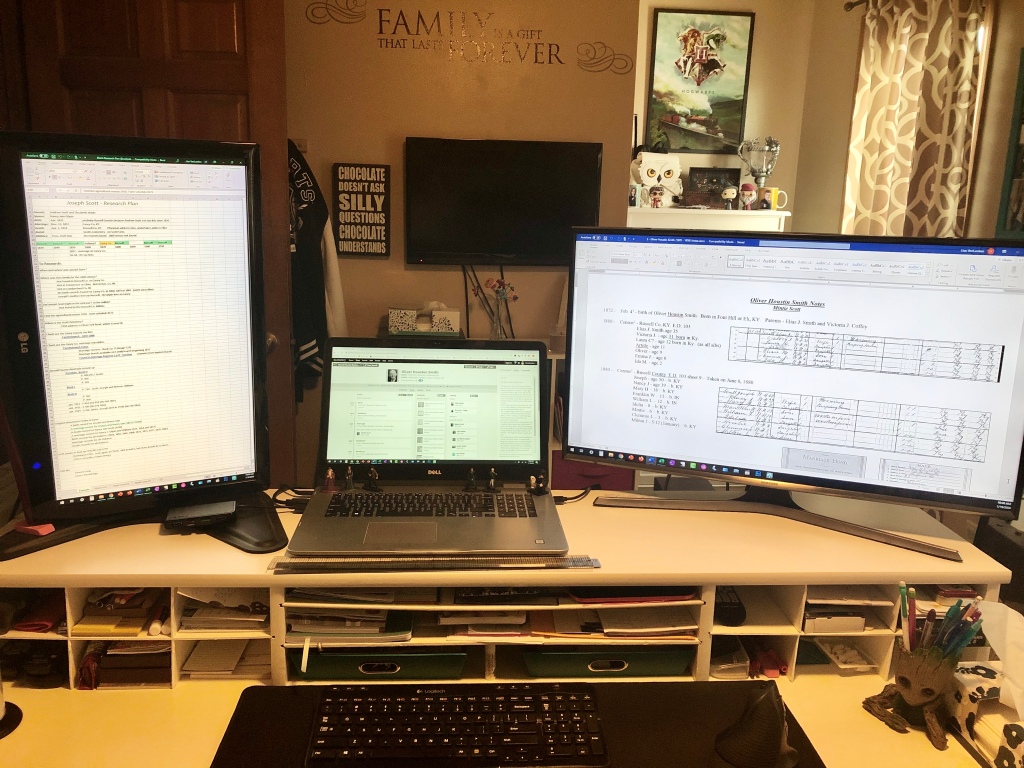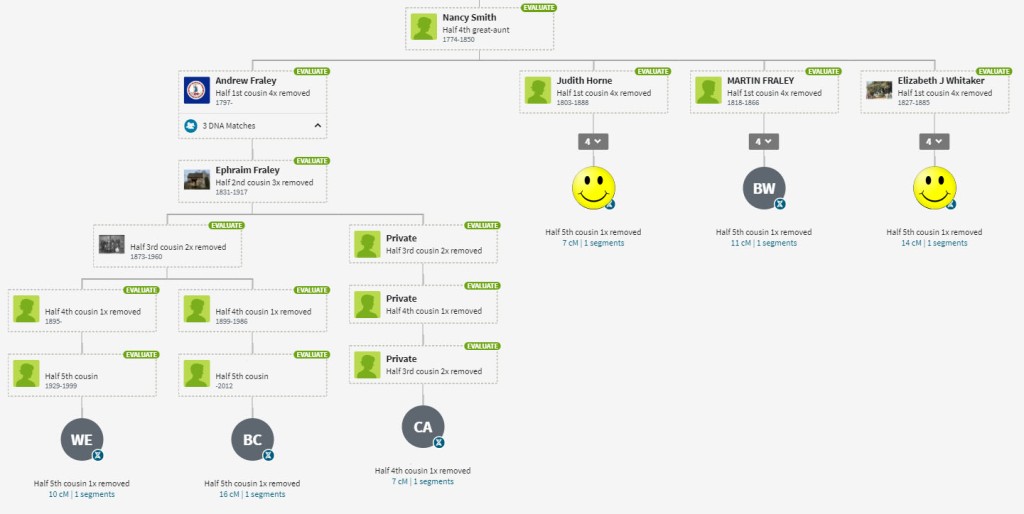Now that I have a few family history books under my belt, I’ve started thinking that I really should be working on my own family history book. I’m planning to think through what I’ve done for the other books and combine the parts that I like the most.
Parts to Include
Biographies
When I worked on updating the book for my husband’s family reunion, I loved the biographies that everyone included for their section. I’d have to write the biographies for my family members myself, but I’ve been researching these people for years, so that shouldn’t be as hard as the ones I wrote for people I’d only researched for a couple of weeks like I did for my daughter-in-law, right? The current notes that I’ve worked on over the years for each couple are in Word format. The notes are organized like a timeline for every document that I have for a person. I would use these notes as the foundation for writing a biography. To enhance the biographies, I’d like to add images, whether it’s actual photos or images of objects to illustrate their lives – carpenter tools from the period, old farm equipment, maps, etc.
One thing I know for sure, whenever I write about a person, I usually find myself down some rabbit hole trying to find the answer to some question that writing has brought to mind. Here’s how that usually goes…
Let’s see how Ancestry has started the LifeStory section for this ancestor and I’ll build on that. “Oliver Houston Smith was born on February 4, 1872, in Russell County, Kentucky, to Victoria I. Coffey, age 23, and Elias Smith, age 27.” OK, that’s good, but I wonder if I actually have the TOWN he was born in. No? Well, maybe I can figure out where his family was living in the 1870 census. (Off to take a look.) Hmmm…it gives a Precinct within the county, but not a town name. Seems like I’ve seen a map showing the voting districts. Can I find that? (Off to take a look.) Maybe I have a deed that will give a description of where the land is. No? Well, does that mean there isn’t one or that I haven’t looked yet? (Off to take a look)
You can see where this is going to lead and I’m only on the first sentence! I need to have a plan in place for this. Something like forcing myself to write with only the information that I currently have and using my research log to track questions that come to mind, but not allow myself to look for answers until I have entered a specific research time. The types of things I enjoy looking for while watching tv in the evenings. Then I would allow myself to update the biography I will have already written. This is a problem that I face EVERY TIME I do research and I just can hardly stick to a goal. “Genealogy ADD”. GADD – as in “Egads, why can’t I ever complete a project!?!
As a former teacher, I’m thinking that I’ll have to treat this as an assignment that I must complete before a certain TIME. What if I had to have it done in 15 minutes? Then and only then make a list of things I’d like to find to add more details. And the list must be in my research log so I can quite wondering if/where I’ve looked for things.
Family Group Sheet
I loved the family group sheet that was put together in the Canvas program on Ancestry for my daughter-in-law’s book. I liked that I added in the current US flag for the year her ancestors were born in place of their portraits. I don’t have many photos of my ancestors, so I think that the flags would add a nice touch of color as well as a bit of history. I also liked adding the current president for the birth years as well. They bring specific history events to mind when you see their portraits. And for those with smaller families, these images and information helped to fill in the bottom part of the page. This part would be fairly easy since I have already collected all the images of flags and presidents and would just need to find the correct ones. Part of this plan would be to have Canvas create the group sheet for me and then “fix” my Ancestry tree for any consistency issues that I see and then create the group sheet again. Consistency issues would include things like: Am I spelling out “County” or using “Co.”? Full state names or abbreviations? Are all of the dates formatted the same? I know when I first started researching, I used Month Day, Year, but now I use Day Month Year. As I’ve researched over the years, I’ve tried to update dates whenever I’ve come across them, but I’m sure there will be some old format dates in any collateral names that might show up in the FGS.
Timeline
If I were only able to complete all of the group sheets and biographies, I’d be pretty happy! I can see using those for books I’d print and give to my children. But for my own, I might also include a timeline, but modified from what I had for my son-in-law.
I have to admit, it was the part of the book that I really had to force myself to work on after completing 3 or 4 of them. Having a timeline is interesting to me, but perhaps not as much to my descendants. On the other hand, you can glance at a timeline and some might not like to read a lengthy biography. I think that if I do include the timeline, I’d like to include more historical items as well. But the real purpose of the timeline for me would be to have thumbnails of all of the documents that I have for a couple. These would all be clickable to allow me to quickly find the documents.
One of the things that was most difficult for the timelines I made for my son-in-law was that events weren’t evenly distributed in nice 10-year gaps. Obviously, there’s a census every 10 years, but some decades had WAY more events than others. So trying to figure out how to organize things into the “traditional” timeline running across the top or bottom of the screen, I could save myself so much more time by formatting the notes that I already have to match the FGS and Biography portions and then adding in the historical events that I think would be interesting.
DNA?
Would it make sense to also try to include the information that I’ve collected on the DNA matches for my family? How long before the information would feel out of date? I’d have to spend more time thinking about what this might look like. I can see how it would helpful to me for my research, but does that need to be in a book? Something to think about.
Who to Include?
I’d like to think about exactly who would be included and how much time each person would receive in my workflow. And a plan like that almost always gets knocked off the rails at some point. I have a new granddaughter arriving this spring and I plan to spend lots of time loving on her! Not to mention gardening season and holidays. Can I allow myself some grace on my timeline for completion?
I’ve done a little thinking about a potential plan. My first thought is that if I want to complete my book by this time next year, then 12 months = 12 ancestors. There are 52 weeks in a year, so if I give 4 weeks to each ancestor, that would be 48 weeks, giving me a few of weeks “off” around the holidays. Twelve ancestors could be 4 great-grandparents plus 8 great-great-grandparents. But do I want to give the females their own sections? Probably not. I’d rather include them with their husbands as I don’t have many records specifically for females in my line – especially if they only married once. So just like my file organization system, I will probably try to think of 12 couples instead of individuals. Who would those couples be?
Grandparents:
- Herman Smith and Vesper Bennett
Great-grandparents:
- Oliver Smith and Mintie Scott
- Enos Bennett and Lelar George
2x great-grandparents:
- Elias Smith and Victoria Coffey
- Joseph Scott and Nancy Jane Gilpin
- Silas Bennett and Mary Elizabeth Rumbo
- William George and Mary Elizabeth Stephens
3x great-grandparents:
- George Smith and Talitha Ellis
- Fielding Coffey and Sarah Jane Hughes*
- Andrew Scott and Elizabeth Wade
- Eli Gilpin and Rebecca Conn
- Green C. Bennett and Emeline Dunbar*
- Jehu Rumbo and Susan Holt
- Henry C. George and Jane LNU*
- Andrew Stephens and Lucy Stephens
That gives me 15 couples. Can I remove 3 of the couples and count them as “bonus” couples if I end up with extra time? (OK, had to stop myself from laughing out loud that I might have time for bonuses!) I added * next to the couples that I think I’ve done the least amount of research on, meaning that I would likely want more than 4 weeks in order to do additional research.
The last thing I want to make a decision on would be how I want to “arrange” my time for each couple. Do I want to complete 1 ancestral couple before moving on to the next couple? I feel like those at the end of the list would most likely be short changed by the end of the year. Perhaps it would be best to plan to do all of the group sheets first and then spend time writing all of the biographies. Then see how much time is left and divide up the remaining time equally. One helpful thing will be that almost all of these couples lived in the same county. If I’m spending time in a specific resource, I can keep my eyes open for the other couples at the same time. But does that fall into my GADD trap? Probably best to immerse myself in one couple at a time.
Staying Organized
For a project of this size, I want to stay organized. I have lots of forms that I use, but I haven’t done research for some of these couples for years. I’m sure there are lots of sources available now that I haven’t searched. So even if I’ve created a form, it will probably need to be updated. I’m thinking that all forms should be put into Excel format, if they aren’t already. And rather than keeping 12 different Excel Workbooks, I should think about a way to keep 1 master workbook for this project. Which forms would I like to include?
- No need for a group sheet since I’m going to have Canvas generate those for me
- On the other hand, I do have many of these already created in Excel, so if I already have them, why not include those?
- Ancestor Inventory sheets
- Land Worksheet
- Research Log
To have this number of worksheets per couple, I think I would need to also have some type of clickable TOC in the front of the workbook to be able to navigate quickly to a specific sheet.
I already have some of these worksheets filled in for my ancestors, so some of the work will simply be combining them into the Master Workbook. For those that I haven’t researched in a while, I’ll be able to fill in the forms as I research.
Now I have the beginnings of a plan. How serious am I about this project? I enjoy the research process so much – the thrill of the hunt – but doesn’t there need to be something to tie it all together? And shouldn’t that “something” be in a form that increases the likelihood that one of my descendants will want to pick up my research after I’m gone?
I think it’s time to stop making plans and just start.












